In 1985, Barker and his colleagues successfully used the external magnetic field of instantaneous pulses to stimulate the motor cortex and peripheral nerves of the human brain for the first time. This non-invasive, painless magnetic stimulation method is called transcranial magnetic stimulation (TMS). Once this technology came out, it caused strong repercussions, and rapidly developed into a non-invasive powerful tool for studying the human nervous system.
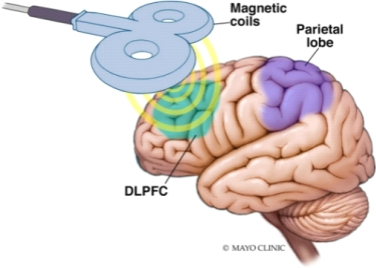
figure 1
After more than 30 years of development, transcranial magnetic stimulation has been widely used in the field of scientific research and clinical treatment, especially repetitive transcranial magnetic stimulation (rTMS), which plays an important role in the research and treatment of clinical diseases, including depression, Parkinson's disease, epilepsy, menstrual pain, spinal cord injury and stroke, etc.
Transcranial magnetic stimulator has two important components: the energy generating device that provides pulse current and the stimulation coil that generates pulse magnetic field. The shape and size of TMS coil play an important role in determining the focus and depth of stimulation in the brain. In the past long period of development of transcranial magnetic technology, researchers have designed many TMS coils with different structures based on different geometric layouts.
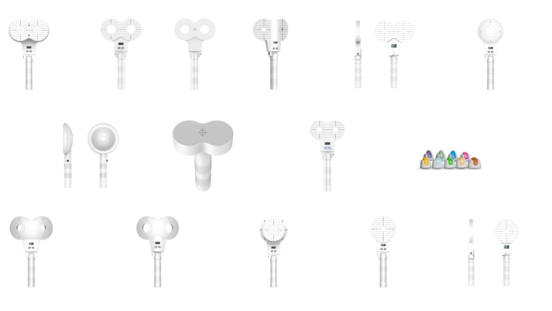
Figure 2
At present, there are two kinds of TMS coils widely used in clinical and scientific research: circular coil and Butterfly coil.
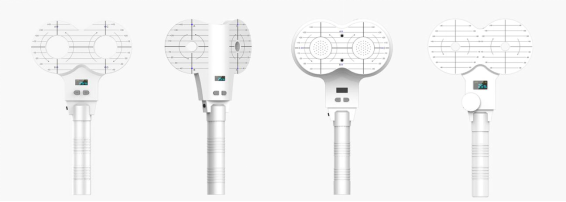
Figure 3
As shown in Figure 3, the Butterfly coil is composed of two coplanar circular coils with currents in opposite directions. The spatial distribution of the magnetic field intensity generated by it is shown in Figure 4, and the distribution of the electric field generated is shown in Figure 5. It can be seen from Figure 5 that the electric field generated by the butterfly coil has two kinds of peaks: the main peak at the junction of the two coils and the side peak on both sides. The amplitude of the main peak is about twice that of the side peak.
This characteristic makes the focusing property of the Butterfly coil much better than other stimulation coils with different structures. The 8-shaped coil has been widely used in experiment and clinic.[2]
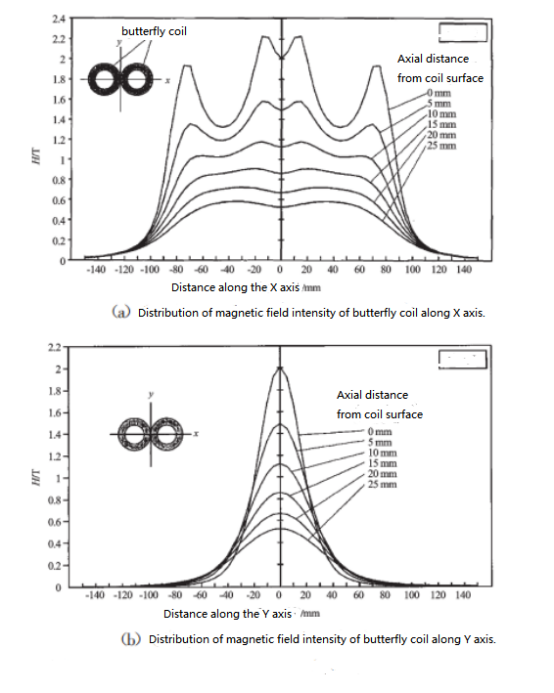
Figure 4
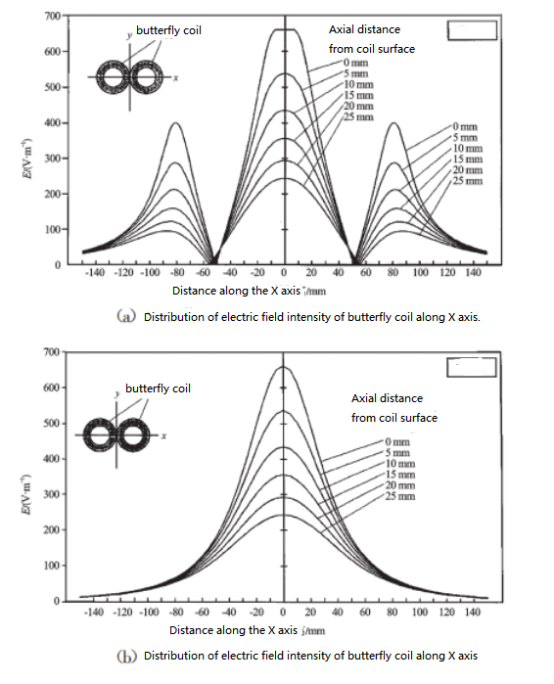
Figure 5
The stimulation of YINGCHI Butterfly coil is deep and focused, and the stimulation depth is about 2-3cm, which can accurately match the stimulation target, and can be satisfied with the mapping of brain functional areas with strict positioning. It is suitable for regional brain function analysis and the treatment of a variety of neurological and psychiatric diseases.
Insomnia is the most common sleep disorder. The common symptoms are difficulty falling asleep, decreased sleep quality and sleep time, and decreased memory and attention.
In a study in 2013, 120 patients with severe chronic insomnia were divided into three study groups: rTMS treatment group, drug treatment group (esmolol) and psychotherapy group. They were treated every day for two weeks. Among them, rTMS treatment group used Butterfly coil, with stimulation frequency of 1Hz and stimulation intensity of 80% threshold to treat the target right dorsolateral prefrontal lobe (R-DLPFC). Polysomnography and other parameters were used to evaluate the three groups before and after treatment.[3]
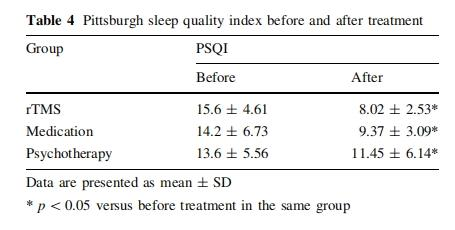
figure 6
The experimental results show that the three treatment methods have significant effects. Compared with the drug treatment group and psychotherapy group, rTMS with Butterfly coil has the best effect in improving phase III and REM sleep.
Depression is a common clinical mental disease with a high incidence rate and a high risk of suicide. In recent years, great progress has been made in the application of transcranial magnetic stimulation (rTMS) in the treatment of depression: 30 + items, including a total of 2000 subjects to study the pseudo stimulus double-blind controlled trial of depression; 15 meta-analysis articles on MDD comprehensive data with high impact factors.
In a randomized, multicenter trial in 2018, 414 subjects diagnosed with major depression were randomly assigned to 10Hz rTMS treatment group (205) and ITBs treatment group (209). The left dorsolateral prefrontal lobe (L-DLPFC) was stimulated with an Butterfly coil once a day, with a total of 20 initial treatments. HRSD-17 and other diagnostic scoring methods were used to track the treatment effect before treatment, after every 5 treatments, 1 week, 4 weeks and 12 weeks after the end of all treatments.[4]
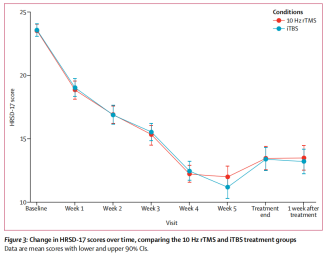
figure 7
The experimental results showed that the HRSD-17 score of 10Hz rTMS group changed from 23.5 (sd4.4) to 13.4 (sd7.8), and the HRSD-17 score of iTBS group changed from 23.6 (sd4.3) to 13.4 (sd7.9). Both of them are very effective in treating the symptoms of patients with depression.
Reference
[1]S. Ueno, T. Tashiro, and K. Harada, “Localized stimulation of neural tissues in the brain by means of paired configuration of time-varying magnetic fields,” Appl. Phys., vol. 64, no. 15, pp. 5862–5864, 1988.
[2]陈福谦,周军,王永波,李丽红。经颅磁刺激线圈结构设计分析综述[J].机电工程,201,431(04):431-436.
[3]Cheng-gang Jiang, Ting Zhang, Fa-guo Yue, Ming-ling Yi. (2013). Efficacy of Repetitive Transcranial Magnetic Stimulation in the Treatment of Patients with Chronic Primary Insomnia. , 67(1), 169–173. doi: 10.1007/s12013-013-9529-4.Blumberger DM, Vila-Rodriguez F, Thorpe KE, Feffer K, Noda Y, Giacobbe P, Knyahnytska Y,
[4]Kennedy SH, Lam RW, Daskalakis ZJ, Downar J. Effectiveness of theta burst versus high-frequency repetitive transcranial magnetic stimulation in patients with depression (THREE-D): a randomised non-inferiority trial. Lancet. 2018 Apr 28; 391(10131):1683-1692. doi: 10.1016/S0140-6736(18)30295-2. Epub 2018 Apr 26. Erratum in: Lancet. 2018 Jun 23; 391(10139):e24 . PMID: 29726344.